Earlier this year I was lucky enough to be able to go to Etruscan classes, run by my colleague Prof. James Clackson with a group of graduate students (including our own Natalia) and other colleagues. Etruscan is one of those great mysteries — a well-attested ancient language that we don’t really understand very well. And I have no intention of trying to solve any mysteries in this post. Instead I want to say a few things from my recent experiences about what we do and don’t know about Etruscan, as well as thinking about the way it was written.
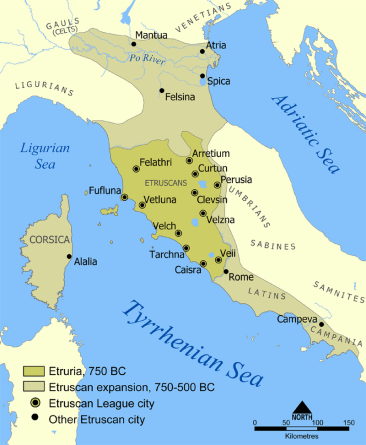 Etruscan is evidently a non-Indo-European language, and one that does not have a close relationship with any other ancient languages we know. While the rest of the Italian peninsula during the 1st millennium BC was filled with Indo-European languages of the Italic branch (Latin, Faliscan, Oscan, Umbrian, Venetic, etc), the unrelated Etruscan language was spoken in quite a large area of central-northern Italy and is found on a wide range of inscription types. In fact there are something in the region of 9,000 surviving inscriptions – so why don’t we understand the language better? Well, we do and we don’t.
Etruscan is evidently a non-Indo-European language, and one that does not have a close relationship with any other ancient languages we know. While the rest of the Italian peninsula during the 1st millennium BC was filled with Indo-European languages of the Italic branch (Latin, Faliscan, Oscan, Umbrian, Venetic, etc), the unrelated Etruscan language was spoken in quite a large area of central-northern Italy and is found on a wide range of inscription types. In fact there are something in the region of 9,000 surviving inscriptions – so why don’t we understand the language better? Well, we do and we don’t.
Actually, some types of inscriptions give us quite a lot to go on. In funerary texts, for instance, we can easily identify which words are names, and then inferring the meaning of some of the other words is not too difficult. Some inscriptions consist of only names, like the one below, which is on a cinerary urn (Etruscan cinerary urns are rather large, elaborate affairs, often bearing a sculpted figure and designed to contain the deceased’s ashes). The deceased woman’s name reads from right to left above the panel depicting fighting men: Θana Vipinei Ranazunia (the Θ is a theta, sometimes transcribed th). The word down the left-hand side, Creicesa, tells us that her husband’s name was Creice.
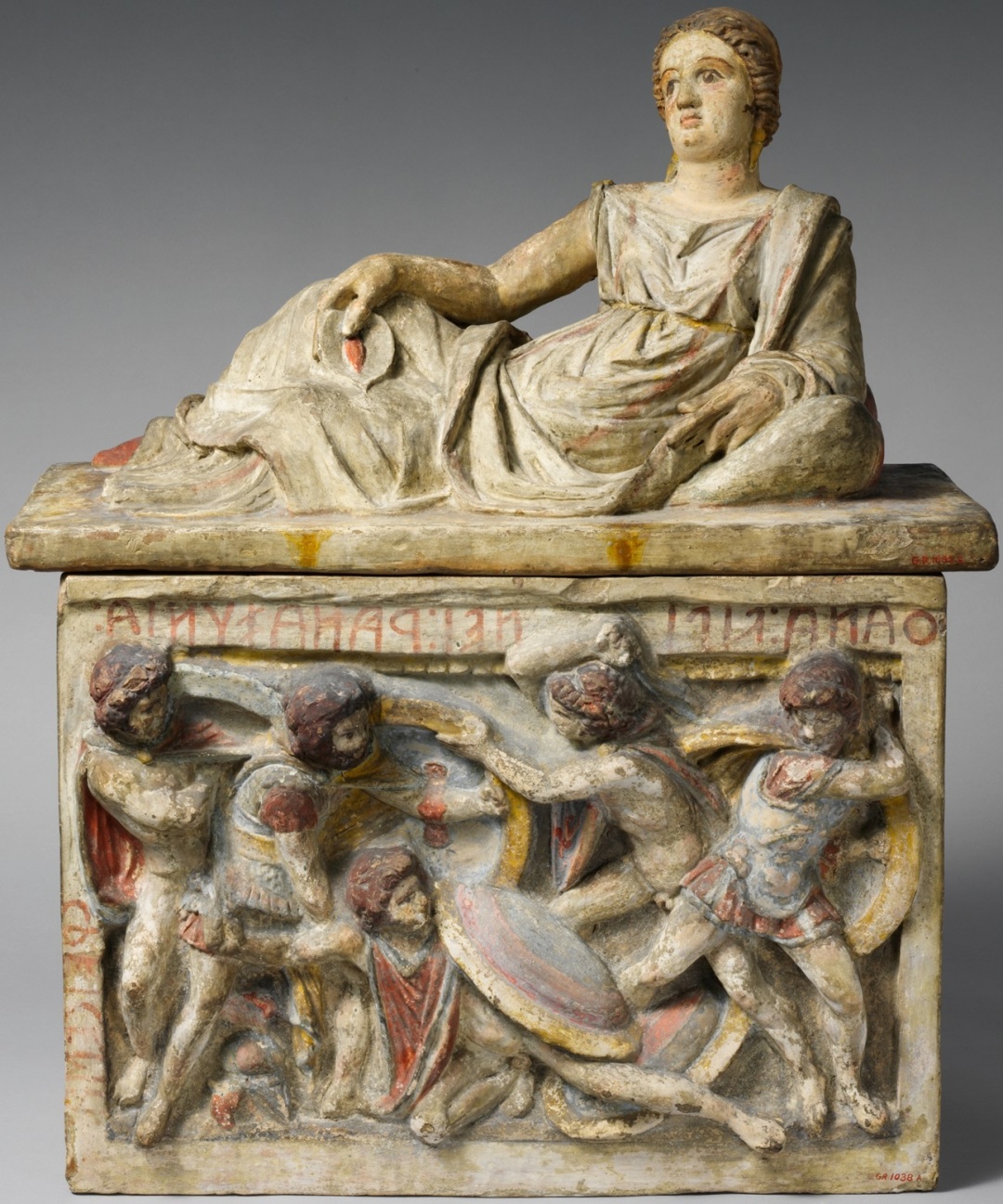

Etruscan onomastics – i.e. the system of conventions for personal names – is one of the areas we understand best in Etruscan language. Working around the identifiable names we know several words for family relations: the word for son is clan and daughter is seχ (χ is a chi, written with a special sign and sometimes transcribed ch or kh), while the word for wife is puia — this word appears around the left hand-corner of the inscription pictured on the right (the cinerary urn of Fastia Velsi, wife of Larza Velu). Unlike in Latin (where a woman’s name derived from her father’s), Etruscan women had distinctive praenomina, with first names like Θana, Fastia, Θanaχvil and Ramaθa. Both patronyms and matronyms could be used to specify individuals. Among male names, the most common we came across in class were Larθ, Arnθ and Vel. (Spotting the extremely common Larθ became a favourite class activity!)
By now you may be wondering how exactly we read these texts, and why you may not find it easy to follow the inscriptions above. The Etruscan alphabet is actually very closely related to the modern ‘Roman’ one (and the ancient Roman one!), but you need to know a few things to understand it. Firstly, almost all Etruscan texts read from right to left. Secondly, although the earliest inscriptions are written basically in the Greek alphabet or something very close to it (as witnessed by the famous abecedarium on an Etruscan cockerel vase below), Etruscan speakers made changes to their alphabet over time.
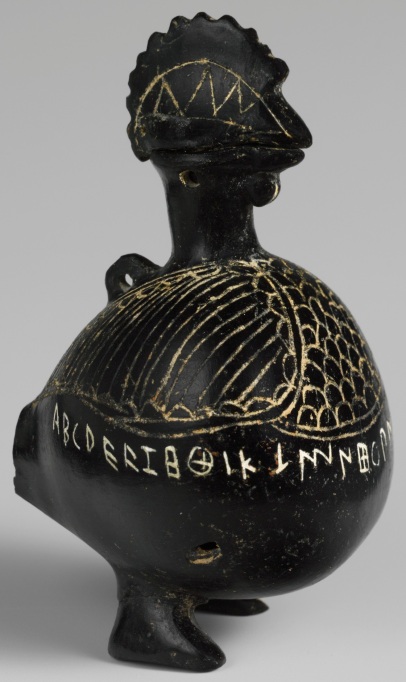
There are some letters that are either new inventions (like the figure-of-eight sign 8 for /f/, a sound that wasn’t present in Greek at the time) or are difficult-to-recognise versions of Greek letters. Rho often tends to look like a capital D (i.e. missing a long stem, though it can sometimes have a stem), theta tends to look like a circle with nothing in the middle (O), what we transcribe as v is written with a digamma (F), pi tends to look like a vertical line with a hook, and so on. Most confusing are the sibilants (s-like sounds): both sigma (an angular-looking S) and san (which looks like a capital M) were used with different values (one perhaps more like ‘s’ and one like ‘sh’ – though reconstructing the exact sounds is difficult). This wouldn’t be so bad if it weren’t for the fact that people used them differently in the northerly areas and the southerly areas where Etruscan was spoken – we think they swapped round the values. The alphabetic sequence of the Etruscan alphabet also changed a little over time, for example as the unused letters beta and delta were removed (‘b’ and ‘d’ sounds do not exist in Etruscan).
See if you can read the inscription below, on a bucchero ware kantharos (two-handled drinking vessel). Don’t forget it goes from right to left.


Did you work it out? Here is the answer, broken up word-by-word, in white text (highlight it to read it): MI REPESUNAS AVILES. This is a ‘speaking object’, and it begins with the Etruscan word for “I” (mi) and addresses the reader in the first person: “I [am the cup of] XY” (where XY = the name of the owner).
You might notice that there is no verb in the sentence in that last inscription. Sadly short inscriptions are often like this! But we are lucky that in Etruscan we have quite a lot of longer inscriptions surviving. One of them is the Capua Tile (or Tabula Capuana), pictured below, which seems to be a ritual calendar although the sense of much of it is difficult to reconstruct because we have a lot of gaps in our knowledge of Etruscan language. For one thing, there are lots of words we just don’t know, ones that may be attested only once or that may appear in obscure contexts where we can only guess what they may mean. It is because we can recognise some month names and deity names, for instance, that we have an idea what the Capua Tile is about, but we are a long way from knowing the meaning of every word.

It is a similar story with the Liber Linteus, the longest and probably the weirdest of Etruscan texts. It’s called the Liber Linteus (“linen book”) because it is written on a very long piece of linen, probably made in the 3rd C BC, that had somehow come to be used as a mummy wrapping in Ptolemaic Egypt. The mummy eventually ended up in Zagreb, Croatia, after being bought in Alexandria, and was unwrapped by its new owner, who displayed the wrappings on his wall without understanding their significance. Eventually it was realised that the text was in Etruscan, containing plenty of recognisable Etruscan words, but also many that we don’t understand.
To take a random sample, in the ninth of the Liber Linteus‘s twelve columns, we find the sequence of words ciem cealχus lauχumneti eisna θaχseri. We know that ciem cealχus means “27” because we can reconstruct quite a few Etruscan numerals. We know that eisna means something like “divine”, and there is another interesting story behind that. The Roman historian Suetonius tells us that a statue of the emperor Augustus was struck by lightning and that the word CAESAR written below the statue was damaged such that the C could no longer be read and the word appeared as AESAR – the priests recognised AESAR as sounding like the Etruscan word for a god, and took this as a sign that Augustus would be deified. This very nice piece of anecdotal evidence helps us here, because eisna seems to be a related word, hence its translation here as “divine” or similar. However, it is very difficult to reconstruct the sense of the other words in the sequence.
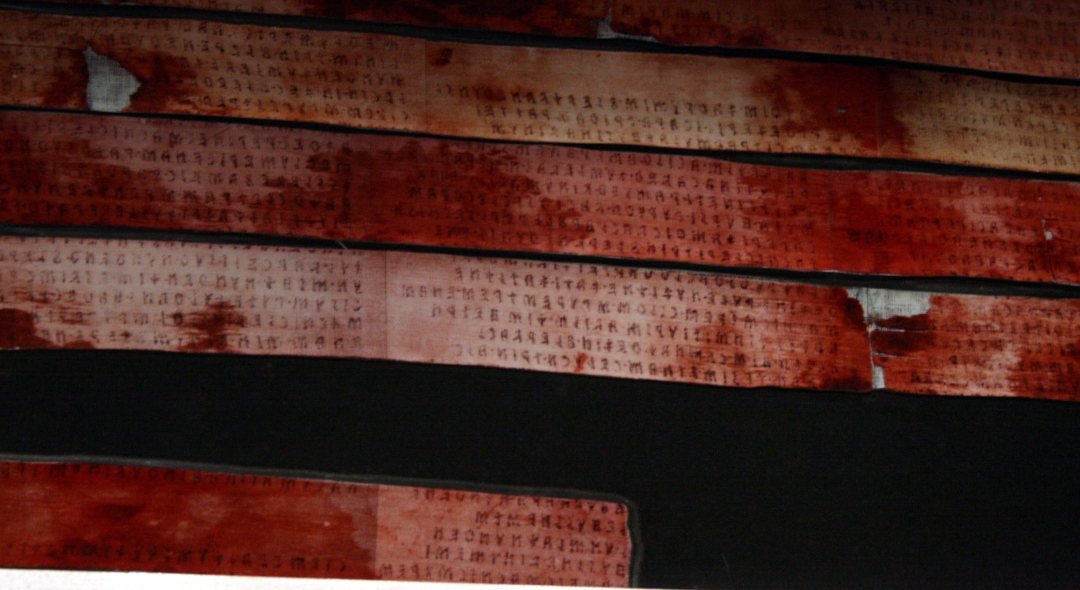

It is difficult to estimate how much Etruscan vocabulary we know. My experience in our Etrsucan classes was that sometimes we are in comfortable territory because familiar words come up in familiar types of inscriptions like ones on tombs or cinerary urns – words for family terms, personal names, and perhaps even numbers, pronouns or certain other well-attested terms. We get the word suθi for a tomb quite often because we have lots of Etruscan tombs. (I’m not sure why this lovely gold ring to the right ended up being marked suθina, “for the tomb”; I suppose the inscription was added before it was buried with the individual in whose tomb it was found, but it seems oddly impersonal.)
Even more tombs, courtesy of my friend and colleague Dr Katherine McDonald:
But getting comfortable with the short inscriptions is like being lulled into a false sense of security. I bet all you language enthusiasts out there are dying for a verb or two! You couldn’t exactly develop Etruscan conversation skills with what we’ve seen so far, unless all you want to do is attend Etruscan funerals and not say too much (my advice is to be a bit more adventurous when you are time travelling). So you’ll be pleased to know that we can identify some Etruscan verbs. The verb ‘to be’ is am-, which is a nice coincidence, while ‘to give’ is tur- and ‘to make’ is cer-. We even know the verb ‘to write’, which is ziχ-, and we know that ziχ is also a noun meaning ‘book’, in part because of the famous inscription on the sarcophagus of Laris Pulenas with its sculpture of the deceased man holding a scroll.
I haven’t seen a better picture than in Katherine’s tweet earlier this year:
The writing on the sculpted scroll is itself a long Etruscan text, and yet again one where we have trouble reconstructing the whole meaning, although it was fun in class trying to read it.
Returning to the language question, we can also make quite a good start in reconstructing morphology. In noun endings, for instance, we can recognise some case endings (e.g. nominative Larθ, genitive Larθal), and we find patterns that look typical of an agglutinating language, where endings can be added in a chain: e.g. clan means “son”, clenar means “sons”, clenaras means “of the sons”. For the verbs we can also recognise different endings for tense or voice: e.g. ame “he/she/it is”, amce “he/she/it was”; or active menece “he/she set up”, passive menaχe “it was set up”. It is a bit like a jigsaw puzzle, because we know that the Etruscan language has a structure but we only have a window on some parts of it, and it is still more difficult to reconstruct the meaning of many words even when we might recognise their endings.
So this is about the size of what we know about Etruscan language. The final inscription I want to show you is the most tantalising, a set of bilingual gold leaf ‘tablets’ inscribed in Phoenician (on the left) and Etruscan (middle and right). We understand Phoenician reasonably well, so you would think that this must be a good way in to Etruscan, wouldn’t you? But sadly the text gives us very little to go on. The Phoenician part is a religious dedication, and we can certainly see parallel names in the Etruscan half: the dedicant is tbryʼ wlnš / Θefariei Velianas (Tiberius Velianas as it would be in Latin), and the goddess to whom the tablets are dedicated is ʻštrt / Unial-Astres (Astarte, who might have been equivalent to the Roman Venus). Beyond that, however, many scholars have wrangled over the details of how the two parts of the text equate to each other, and the debate continues.
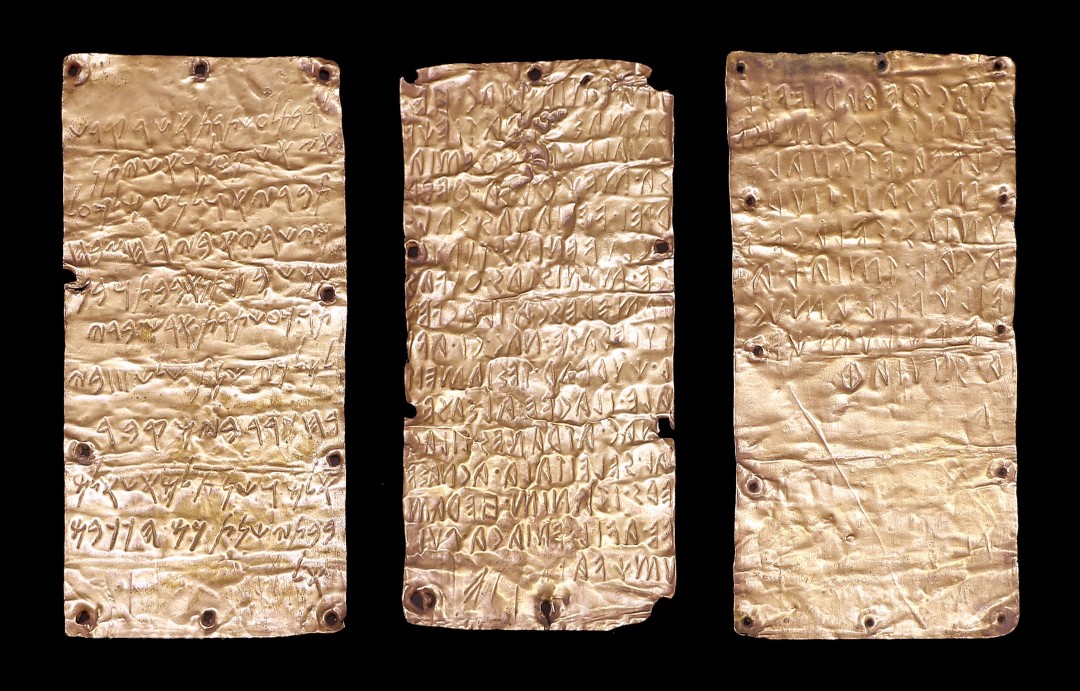
It was a real privilege to be able to study a bit of Etruscan with colleagues here in Cambridge, and I know that not many people have the opportunity to learn about the language in such a lovely collaborative setting. I hope this post has given some idea of what Etruscan feels like to work with – to a relative beginner like me anyway. We don’t really understand it, and yet there is a lot about it that we do understand. I haven’t even had a chance to get started on the context of Etruscan writing beyond a few snippets here and there, but if you are getting the impression of a lavish, distinctive and highly literate culture, then I would say that is not to far off the mark, at least for the upper echelons of society who could afford high status tombs and other inscribed objects. I think this might just be the best-looking post I have written for the CREWS blog too!
~ Pippa Steele (Principal Investigator of the CREWS project)

The image at the top of this post is a facsimile of painting on back wall, right side, of the Tomba degli Scudi. Image from the Boston MFA.

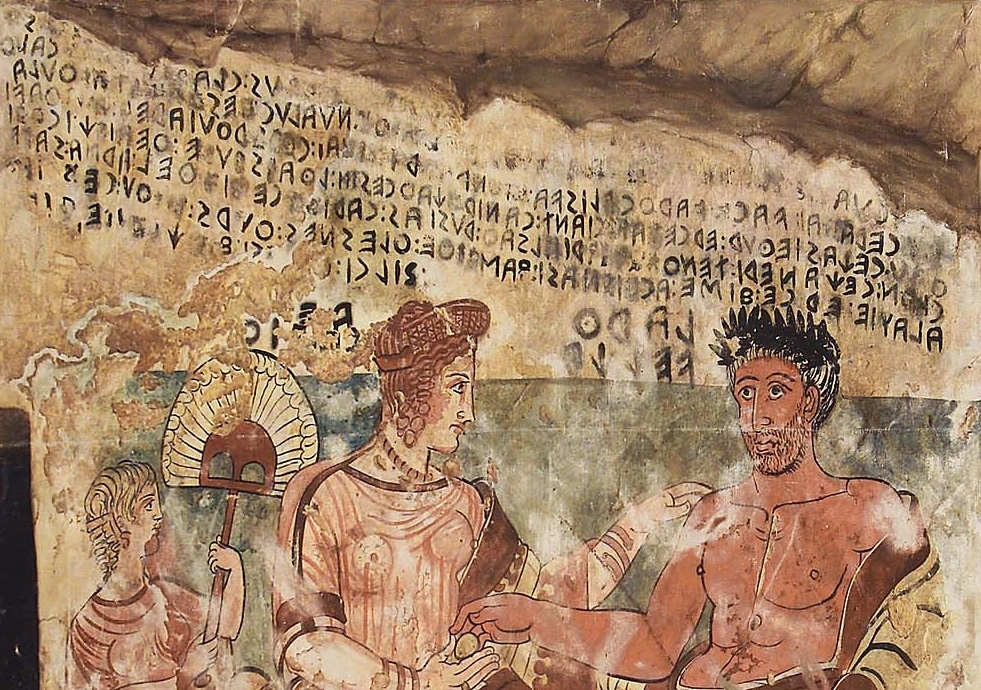
WOW ! this is amazing Pippa but I think I’ll stick to Linear B. The Etruscan language seems far too difficult. Thank you for sharing your knowledge.
LikeLiked by 1 person
Thank you Rita! It really does feel quite difficult – especially that there’s so much of it and yet we still don’t understand it very well!
LikeLiked by 1 person
Always been interested in the Etruscans. Wonderful project
LikeLiked by 1 person
Thank you so much!
LikeLike
I was amused to read the remark that we understand Phoenician reasonably well. I have just finished reading Roberto Casti’s book on the Stele of Nora with around 40 Phoenician characters – which scholars have spent some 200 years struggling to interpret. The various wildly diverging translations suggest we barely understand Phoenician.
LikeLiked by 1 person
Yes, it’s a bit generous to say ‘reasonably well’, isn’t it?! I think the Nora Stele is a particularly controversial example, but there are plenty of other Phoenician inscriptions that defy interpretation. If a Phoenician text is relatively long and well contextualised, or even if it is short but well contextualised, the chance of interpreting it is greatly increased. Later on Phoenician dedications and tombstones become quite formulaic, which also helps, and of course knowing how closely it is related to other NW Semitic languages gives great scope for comparative philology. But you are quite right that there are still many mysteries! Much better understood than Etruscan overall, but the fact that we can wrangle over the interpretation of one short text like the Nora stele just shows how incomplete our knowledge is.
LikeLike
This is by far the most well written and interesting piece I have read in awhile.
LikeLiked by 2 people
Thank you so much!
LikeLike
I would love to know how the LIber Linteus got to Egypt. I have read that the mummy it enclosed was someone who lived quite a while after the text was written. There seems no obvious explanation – I like to imagine a group of Etruscan priests going off to Egypt on a fact-finding mission and taking it with them as a guest-gift!
LikeLiked by 1 person
Yes, my understanding is that the Etruscan text looks like it could have been written around 500 BC (going by its palaeography) but the mummy was probaby wrapped in the 3rd C BC. Quite a mystery, and I suppose we have no way of solving it, but I like your theory!
LikeLike
Fantastic article! I found this and also the Nativlang youtube video on Etruscan fascinating. I just have one question. I am Irish and like Etruscan, the word for children in Irish is clann. This survives in English as clan. In Old Irish this was cland. Is there any chance of a connection between the two? Perhaps Proto-Celtic and Etruscan were near each other and some loan words entered each language. Let me know what you think!
LikeLiked by 1 person
Thank you very much! I believe cland/clann is derived from Latin planta, which means something like ‘offshoot’ and hence ‘offspring’ (I know that sounds strange but Old Irish didn’t have a p phoneme!). So I suspect Etruscan clan is unrelated – what we call a ‘false friend’ in linguistics (a word that looks like it is related to another but isn’t).
LikeLike